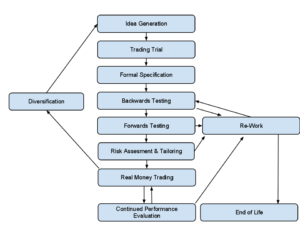Here is a discussion that happened in my trading group this weekend. Mr. Hertel was kind enough to let me share it with my readers. I think it really answers the core question for New Traders on how to get started trading in a systematic way. For anyone interested in joining a high quality group of traders with the purpose to learn ans share add me on facebook and I can join you to the private group.
Rahul Kumar: We know that there are many out there selling their systems. I am looking for one. can anyone recommend a successful one please? Thanks.
Riccardo Hertel: I believe that there can be no shortcut: You will have to develop your own system. What works for one person may be bad for another. A lot of emotions involved in trading. Don’t trust anyone providing you the one simple solution. My advice would be that you learn, read and try what fits best to you. The books of Van Tharp describe these aspects very nicely.
Don’t waste your time with any book that presents a given strategy as the only, ultimate and infallible approach. What looks too good to be true usually is.
Any reasonable system will provide you an entry signal as well as an exit signal and/or a target. What seems like the essence of trading (knowing when to buy and when to sell) is paradoxically one of the least important aspects of successful trading. Whether you use moving averages, classical chart analysis, fundamental analysis, Elliott waves, Fibonacci retracements or any other method is of secondary importance. Each of them can work, but none of them is in itself sufficient for being a successful trader.
Risk- and money management (position sizing) is in any case extremely important. Van Tharp was the first trader who pointed this out, and it is worth reading the original works. I particularly liked “Trade your Way to Financial Freedom”.
In addition to position sizing, entry and exit, the product of risk-reward ratio and the percentage of winning trades is a delicate aspect that has much to do with the personality of the trader. Do you have the nerves to stand, say, eight losing trades in a row and wait patiently for the one trade that over-compensates all the previous losses? Or do you prefer having a higher percentage of winning trades, like 60% or so, but with a smaller difference between the amounts that you gain in winning trades compared to what you lose in trades that go wrong? With the position of you stop-loss you can “tune” these factors to a large extent. Put it very close to your entry point, and you will have a high probability of getting stopped out, but also a much higher reward/risk ratio.
Placing the stop loss correctly (or in the way that suits you best) is a difficult thing to find out. Typical approaches are based on the ATR or the position of technical support/resistance levels.
Finally, there is also a lot to learn about hedging, portfolio structure and ROR. In view of these factors, the “system” in terms of entries and exits is relatively unimportant. If all the rest is working properly, even a coin toss will do.
Riccardo Hertel, born in 1970, is a theoretical physicist. In the aftermath of the crash of 2008 he developed a strong interest in financial markets and trading. He participates in the financial markets on a daily basis and his trading decisions are based on chart analysis. Since three years, Dr. Hertel has been managing a trading service at the German www.godmode-trader.de, a site that is focused on Technical Analysis, where he publishes a detailed chart analysis every day.
